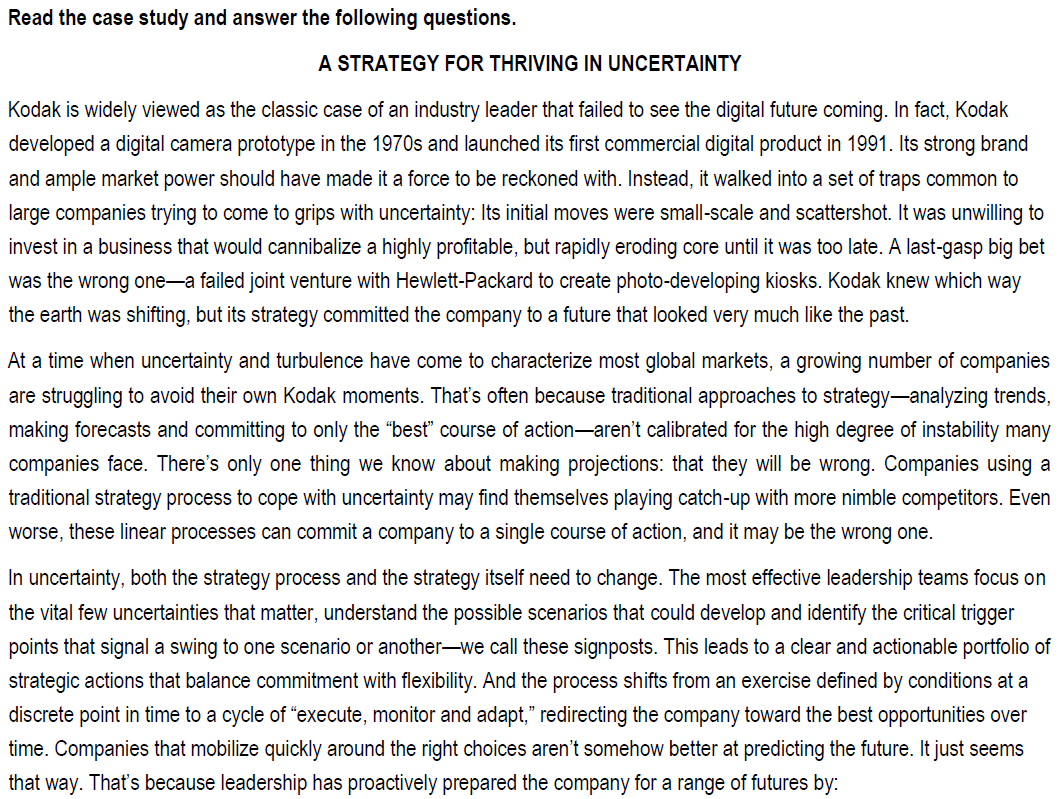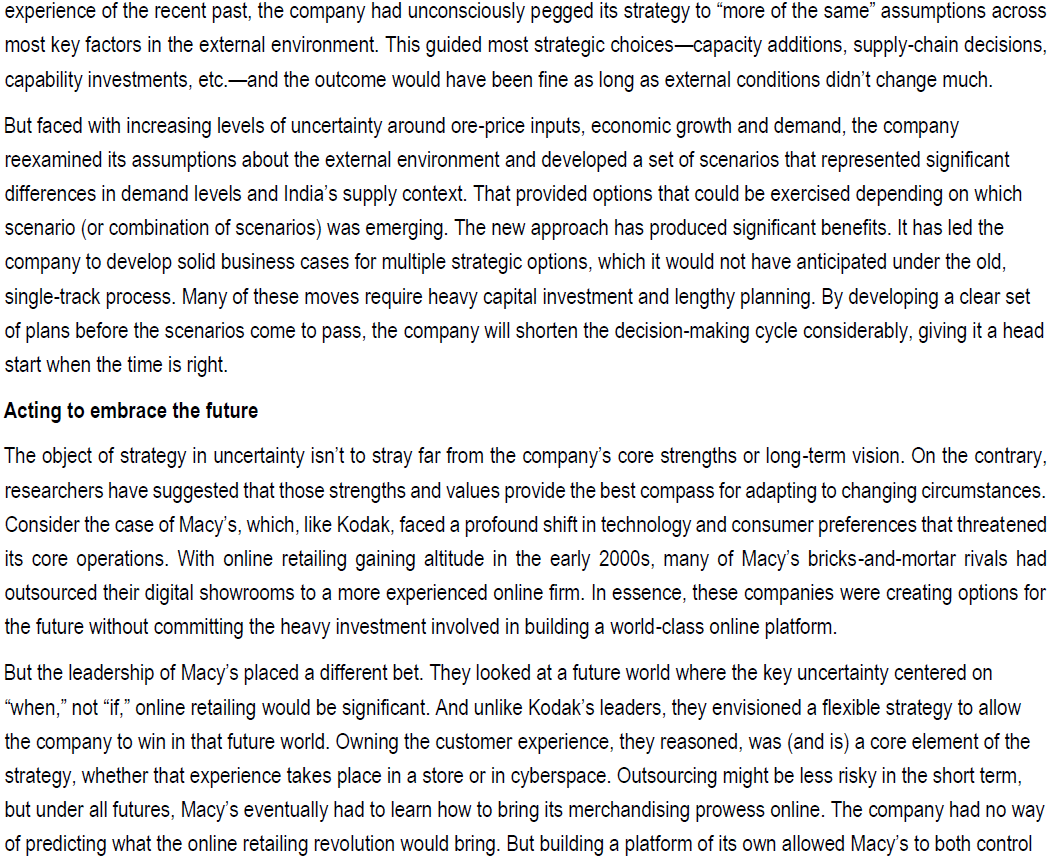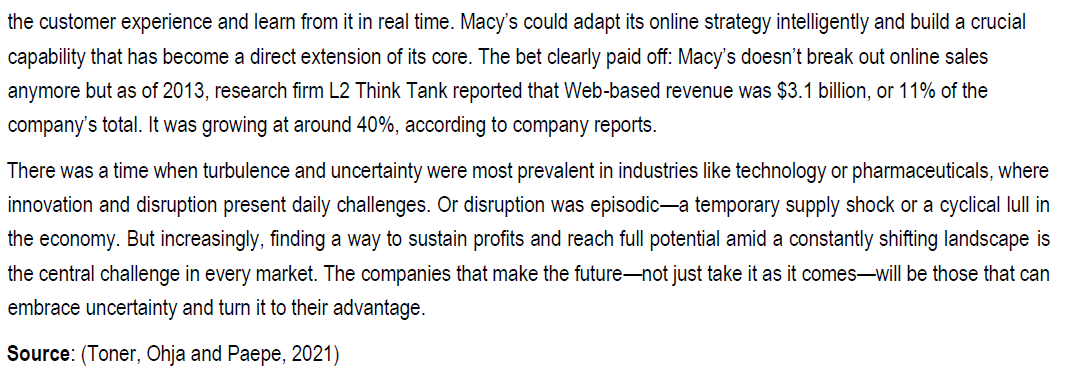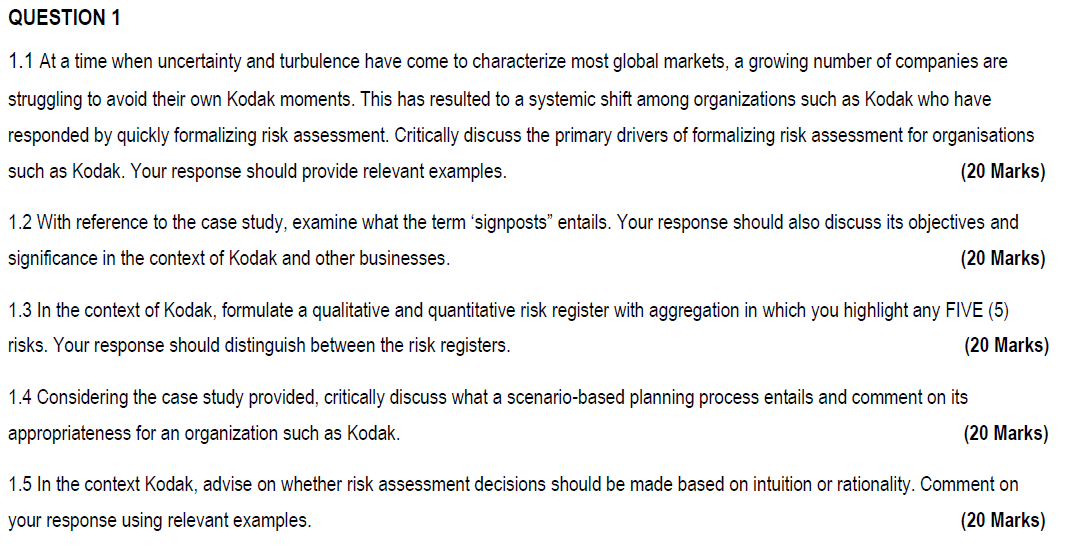Answered step by step
Verified Expert Solution
Question
1 Approved Answer
experience of the recent past, the company had unconsciously pegged its strategy to more of the same assumptions across most key factors in the external




 experience of the recent past, the company had unconsciously pegged its strategy to "more of the same" assumptions across most key factors in the external environment. This guided most strategic choices-capacity additions, supply-chain decisions, capability investments, etc.-and the outcome would have been fine as long as external conditions didn't change much. But faced with increasing levels of uncertainty around ore-price inputs, economic growth and demand, the company reexamined its assumptions about the external environment and developed a set of scenarios that represented significant differences in demand levels and India's supply context. That provided options that could be exercised depending on which scenario (or combination of scenarios) was emerging. The new approach has produced significant benefits. It has led the company to develop solid business cases for multiple strategic options, which it would not have anticipated under the old, single-track process. Many of these moves require heavy capital investment and lengthy planning. By developing a clear set of plans before the scenarios come to pass, the company will shorten the decision-making cycle considerably, giving it a head start when the time is right. Acting to embrace the future The object of strategy in uncertainty isn't to stray far from the company's core strengths or long-term vision. On the contrary, researchers have suggested that those strengths and values provide the best compass for adapting to changing circumstances. Consider the case of Macy's, which, like Kodak, faced a profound shift in technology and consumer preferences that threatened its core operations. With online retailing gaining altitude in the early 2000s, many of Macy's bricks-and-mortar rivals had outsourced their digital showrooms to a more experienced online firm. In essence, these companies were creating options for the future without committing the heavy investment involved in building a world-class online platform. But the leadership of Macy's placed a different bet. They looked at a future world where the key uncertainty centered on "when," not "if," online retailing would be significant. And unlike Kodak's leaders, they envisioned a flexible strategy to allow the company to win in that future world. Owning the customer experience, they reasoned, was (and is) a core element of the strategy, whether that experience takes place in a store or in cyberspace. Outsourcing might be less risky in the short term, but under all futures, Macy's eventually had to learn how to bring its merchandising prowess online. The company had no way of predicting what the online retailing revolution would bring. But building a platform of its own allowed Macy's to both control the customer experience and learn from it in real time. Macy's could adapt its online strategy intelligently and build a crucial capability that has become a direct extension of its core. The bet clearly paid off: Macy's doesn't break out online sales anymore but as of 2013, research firm L2 Think Tank reported that Web-based revenue was $3.1 billion, or 11% of the company's total. It was growing at around 40%, according to company reports. There was a time when turbulence and uncertainty were most prevalent in industries like technology or pharmaceuticals, where innovation and disruption present daily challenges. Or disruption was episodic-a temporary supply shock or a cyclical lull in the economy. But increasingly, finding a way to sustain profits and reach full potential amid a constantly shifting landscape is the central challenge in every market. The companies that make the future-not just take it as it comes-will be those that car embrace uncertainty and turn it to their advantage. Source: (Toner, Ohja and Paepe, 2021) 1.1 At a time when uncertainty and turbulence have come to characterize most global markets, a growing number of companies are struggling to avoid their own Kodak moments. This has resulted to a systemic shift among organizations such as Kodak who have responded by quickly formalizing risk assessment. Critically discuss the primary drivers of formalizing risk assessment for organisations such as Kodak. Your response should provide relevant examples. (20 Marks) 1.2 With reference to the case study, examine what the term 'signposts" entails. Your response should also discuss its objectives and significance in the context of Kodak and other businesses. (20 Marks) 1.3 In the context of Kodak, formulate a qualitative and quantitative risk register with aggregation in which you highlight any FIVE (5) risks. Your response should distinguish between the risk registers. (20 Marks) 1.4 Considering the case study provided, critically discuss what a scenario-based planning process entails and comment on its appropriateness for an organization such as Kodak. (20 Marks) 1.5 In the context Kodak, advise on whether risk assessment decisions should be made based on intuition or rationality. Comment on your response using relevant examples. (20 Marks) A STRATEGY FOR THRIVING IN UNCERTAINTY Kodak is widely viewed as the classic case of an industry leader that failed to see the digital future coming. In fact, Kodak developed a digital camera prototype in the 1970s and launched its first commercial digital product in 1991. Its strong brand and ample market power should have made it a force to be reckoned with. Instead, it walked into a set of traps common to large companies trying to come to grips with uncertainty: Its initial moves were small-scale and scattershot. It was unwilling to invest in a business that would cannibalize a highly profitable, but rapidly eroding core until it was too late. A last-gasp big bet was the wrong one-a failed joint venture with Hewlett-Packard to create photo-developing kiosks. Kodak knew which way the earth was shifting, but its strategy committed the company to a future that looked very much like the past. At a time when uncertainty and turbulence have come to characterize most global markets, a growing number of companies are struggling to avoid their own Kodak moments. That's often because traditional approaches to strategy-analyzing trends, making forecasts and committing to only the "best" course of action-aren't calibrated for the high degree of instability many companies face. There's only one thing we know about making projections: that they will be wrong. Companies using a traditional strategy process to cope with uncertainty may find themselves playing catch-up with more nimble competitors. Even worse, these linear processes can commit a company to a single course of action, and it may be the wrong one. In uncertainty, both the strategy process and the strategy itself need to change. The most effective leadership teams focus on the vital few uncertainties that matter, understand the possible scenarios that could develop and identify the critical trigger points that signal a swing to one scenario or another-we call these signposts. This leads to a clear and actionable portfolio of strategic actions that balance commitment with flexibility. And the process shifts from an exercise defined by conditions at a discrete point in time to a cycle of "execute, monitor and adapt," redirecting the company toward the best opportunities over time. Companies that mobilize quickly around the right choices aren't somehow better at predicting the future. It just seems that way. That's because leadership has proactively prepared the company for a range of futures by: Defining which uncertainties, the company faces and cutting through the noise by separating them into those that matter and those that don't. Creating a set of probable scenarios for how the future might unfold and discussing the threats - and opportunitiesthat these scenarios present. Devising a specific set of strategic options that balance commitment to a course of action with the flexibility to adjust and thrive amid different future scenarios. Identifying a clear set of signposts that will signal important changes in the marketplace and trigger a set of actions already foreseen during the scenario-planning process. This is very different from what many call "sensitivity analysis." It's about creating a coherent set of scenarios across all critical variables in an analytically rigorous fashion. That helps leadership teams address a number of key questions: What are the most likely possible scenarios to emerge from the major uncertainties the company faces and what should it look like to thrive in each one? How could the world evolve in a way that could either disrupt current strategy or create new opportunities? How can the company act quickly depending on which possible future unfolds? The goal is to prod leadership to monitor change on a regular basis and move ahead of competitors as future states begin to take shape. Rather than adopting a wait-and-see approach to planning and investment, leadership is aligned and "precommitted" to take specific action under different circumstances. If the world is evolving toward scenario X, the company has already laid plans to roll out strategy Y. For one of the largest industrial companies in India, switching to a scenariobased planning process proved to be game changing in how leadership approached strategy development. Based largely on the
experience of the recent past, the company had unconsciously pegged its strategy to "more of the same" assumptions across most key factors in the external environment. This guided most strategic choices-capacity additions, supply-chain decisions, capability investments, etc.-and the outcome would have been fine as long as external conditions didn't change much. But faced with increasing levels of uncertainty around ore-price inputs, economic growth and demand, the company reexamined its assumptions about the external environment and developed a set of scenarios that represented significant differences in demand levels and India's supply context. That provided options that could be exercised depending on which scenario (or combination of scenarios) was emerging. The new approach has produced significant benefits. It has led the company to develop solid business cases for multiple strategic options, which it would not have anticipated under the old, single-track process. Many of these moves require heavy capital investment and lengthy planning. By developing a clear set of plans before the scenarios come to pass, the company will shorten the decision-making cycle considerably, giving it a head start when the time is right. Acting to embrace the future The object of strategy in uncertainty isn't to stray far from the company's core strengths or long-term vision. On the contrary, researchers have suggested that those strengths and values provide the best compass for adapting to changing circumstances. Consider the case of Macy's, which, like Kodak, faced a profound shift in technology and consumer preferences that threatened its core operations. With online retailing gaining altitude in the early 2000s, many of Macy's bricks-and-mortar rivals had outsourced their digital showrooms to a more experienced online firm. In essence, these companies were creating options for the future without committing the heavy investment involved in building a world-class online platform. But the leadership of Macy's placed a different bet. They looked at a future world where the key uncertainty centered on "when," not "if," online retailing would be significant. And unlike Kodak's leaders, they envisioned a flexible strategy to allow the company to win in that future world. Owning the customer experience, they reasoned, was (and is) a core element of the strategy, whether that experience takes place in a store or in cyberspace. Outsourcing might be less risky in the short term, but under all futures, Macy's eventually had to learn how to bring its merchandising prowess online. The company had no way of predicting what the online retailing revolution would bring. But building a platform of its own allowed Macy's to both control the customer experience and learn from it in real time. Macy's could adapt its online strategy intelligently and build a crucial capability that has become a direct extension of its core. The bet clearly paid off: Macy's doesn't break out online sales anymore but as of 2013, research firm L2 Think Tank reported that Web-based revenue was $3.1 billion, or 11% of the company's total. It was growing at around 40%, according to company reports. There was a time when turbulence and uncertainty were most prevalent in industries like technology or pharmaceuticals, where innovation and disruption present daily challenges. Or disruption was episodic-a temporary supply shock or a cyclical lull in the economy. But increasingly, finding a way to sustain profits and reach full potential amid a constantly shifting landscape is the central challenge in every market. The companies that make the future-not just take it as it comes-will be those that car embrace uncertainty and turn it to their advantage. Source: (Toner, Ohja and Paepe, 2021) 1.1 At a time when uncertainty and turbulence have come to characterize most global markets, a growing number of companies are struggling to avoid their own Kodak moments. This has resulted to a systemic shift among organizations such as Kodak who have responded by quickly formalizing risk assessment. Critically discuss the primary drivers of formalizing risk assessment for organisations such as Kodak. Your response should provide relevant examples. (20 Marks) 1.2 With reference to the case study, examine what the term 'signposts" entails. Your response should also discuss its objectives and significance in the context of Kodak and other businesses. (20 Marks) 1.3 In the context of Kodak, formulate a qualitative and quantitative risk register with aggregation in which you highlight any FIVE (5) risks. Your response should distinguish between the risk registers. (20 Marks) 1.4 Considering the case study provided, critically discuss what a scenario-based planning process entails and comment on its appropriateness for an organization such as Kodak. (20 Marks) 1.5 In the context Kodak, advise on whether risk assessment decisions should be made based on intuition or rationality. Comment on your response using relevant examples. (20 Marks) A STRATEGY FOR THRIVING IN UNCERTAINTY Kodak is widely viewed as the classic case of an industry leader that failed to see the digital future coming. In fact, Kodak developed a digital camera prototype in the 1970s and launched its first commercial digital product in 1991. Its strong brand and ample market power should have made it a force to be reckoned with. Instead, it walked into a set of traps common to large companies trying to come to grips with uncertainty: Its initial moves were small-scale and scattershot. It was unwilling to invest in a business that would cannibalize a highly profitable, but rapidly eroding core until it was too late. A last-gasp big bet was the wrong one-a failed joint venture with Hewlett-Packard to create photo-developing kiosks. Kodak knew which way the earth was shifting, but its strategy committed the company to a future that looked very much like the past. At a time when uncertainty and turbulence have come to characterize most global markets, a growing number of companies are struggling to avoid their own Kodak moments. That's often because traditional approaches to strategy-analyzing trends, making forecasts and committing to only the "best" course of action-aren't calibrated for the high degree of instability many companies face. There's only one thing we know about making projections: that they will be wrong. Companies using a traditional strategy process to cope with uncertainty may find themselves playing catch-up with more nimble competitors. Even worse, these linear processes can commit a company to a single course of action, and it may be the wrong one. In uncertainty, both the strategy process and the strategy itself need to change. The most effective leadership teams focus on the vital few uncertainties that matter, understand the possible scenarios that could develop and identify the critical trigger points that signal a swing to one scenario or another-we call these signposts. This leads to a clear and actionable portfolio of strategic actions that balance commitment with flexibility. And the process shifts from an exercise defined by conditions at a discrete point in time to a cycle of "execute, monitor and adapt," redirecting the company toward the best opportunities over time. Companies that mobilize quickly around the right choices aren't somehow better at predicting the future. It just seems that way. That's because leadership has proactively prepared the company for a range of futures by: Defining which uncertainties, the company faces and cutting through the noise by separating them into those that matter and those that don't. Creating a set of probable scenarios for how the future might unfold and discussing the threats - and opportunitiesthat these scenarios present. Devising a specific set of strategic options that balance commitment to a course of action with the flexibility to adjust and thrive amid different future scenarios. Identifying a clear set of signposts that will signal important changes in the marketplace and trigger a set of actions already foreseen during the scenario-planning process. This is very different from what many call "sensitivity analysis." It's about creating a coherent set of scenarios across all critical variables in an analytically rigorous fashion. That helps leadership teams address a number of key questions: What are the most likely possible scenarios to emerge from the major uncertainties the company faces and what should it look like to thrive in each one? How could the world evolve in a way that could either disrupt current strategy or create new opportunities? How can the company act quickly depending on which possible future unfolds? The goal is to prod leadership to monitor change on a regular basis and move ahead of competitors as future states begin to take shape. Rather than adopting a wait-and-see approach to planning and investment, leadership is aligned and "precommitted" to take specific action under different circumstances. If the world is evolving toward scenario X, the company has already laid plans to roll out strategy Y. For one of the largest industrial companies in India, switching to a scenariobased planning process proved to be game changing in how leadership approached strategy development. Based largely on the Step by Step Solution
There are 3 Steps involved in it
Step: 1

Get Instant Access to Expert-Tailored Solutions
See step-by-step solutions with expert insights and AI powered tools for academic success
Step: 2

Step: 3

Ace Your Homework with AI
Get the answers you need in no time with our AI-driven, step-by-step assistance
Get Started


